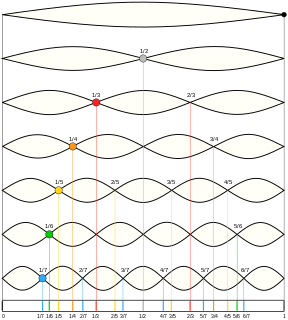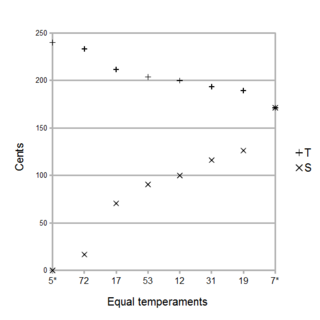
A musical keyboard is the set of adjacent depressible levers or keys on a musical instrument. Keyboards typically contain keys for playing the twelve notes of the Western musical scale, with a combination of larger, longer keys and smaller, shorter keys that repeats at the interval of an octave. Depressing a key on the keyboard makes the instrument produce sounds—either by mechanically striking a string or tine, plucking a string (harpsichord), causing air to flow through a pipe organ, striking a bell (carillon), or, on electric and electronic keyboards, completing a circuit. Since the most commonly encountered keyboard instrument is the piano, the keyboard layout is often referred to as the piano keyboard.

In music, there are two common meanings for tuning:

A harmonic is any member of the harmonic series. The term is employed in various disciplines, including music, physics, acoustics, electronic power transmission, radio technology, and other fields. It is typically applied to repeating signals, such as sinusoidal waves. A harmonic is a wave with a frequency that is a positive integer multiple of the frequency of the original wave, known as the fundamental frequency. The original wave is also called the 1st harmonic, the following harmonics are known as higher harmonics. As all harmonics are periodic at the fundamental frequency, the sum of harmonics is also periodic at that frequency. For example, if the fundamental frequency is 50 Hz, a common AC power supply frequency, the frequencies of the first three higher harmonics are 100 Hz, 150 Hz, 200 Hz and any addition of waves with these frequencies is periodic at 50 Hz.
An nth characteristic mode, for n > 1, will have nodes that are not vibrating. For example, the 3rd characteristic mode will have nodes at L and L, where L is the length of the string. In fact, each nth characteristic mode, for n not a multiple of 3, will not have nodes at these points. These other characteristic modes will be vibrating at the positions L and L. If the player gently touches one of these positions, then these other characteristic modes will be suppressed. The tonal harmonics from these other characteristic modes will then also be suppressed. Consequently, the tonal harmonics from the nth characteristic modes, where n is a multiple of 3, will be made relatively more prominent.

Meantone temperament is a musical temperament, that is a tuning system, obtained by compromising the fifths so that their ratio is slightly less than 3:2, in order to push the major thirds closer to a 5:4 ratio. Meantone temperaments are constructed the same way as Pythagorean tuning, as a stack of equal fifths.

In music theory, the wolf fifth is a particularly dissonant musical interval spanning seven semitones. Strictly, the term refers to an interval produced by a specific tuning system, widely used in the sixteenth and seventeenth centuries: the quarter-comma meantone temperament. More broadly, it is also used to refer to similar intervals produced by other tuning systems, including most meantone temperaments.
Contemporary classical music is classical music composed close to the present day. At the beginning of the 21st century, it commonly referred to the post-1945 modern forms of post-tonal music after the death of Anton Webern, and included serial music, electronic music, experimental music, and minimalist music. Newer forms of music include spectral music, and post-minimalism.

Regular temperament is any tempered system of musical tuning such that each frequency ratio is obtainable as a product of powers of a finite number of generators, or generating frequency ratios. For instance, in 12-TET, the system of music most commonly used in the Western world, the generator is a tempered fifth, which is the basis behind the circle of fifths.

In music, consonance and dissonance are categorizations of simultaneous or successive sounds. Within the Western tradition, some listeners associate consonance with sweetness, pleasantness, and acceptability, and dissonance with harshness, unpleasantness, or unacceptability, although there is broad acknowledgement that this depends also on familiarity and musical expertise. The terms form a structural dichotomy in which they define each other by mutual exclusion: a consonance is what is not dissonant, and a dissonance is what is not consonant. However, a finer consideration shows that the distinction forms a gradation, from the most consonant to the most dissonant. In casual discourse, as Hindemith stressed, "The two concepts have never been completely explained, and for a thousand years the definitions have varied". The term sonance has been proposed to encompass or refer indistinctly to the terms consonance and dissonance.

In music, 31 equal temperament, 31-ET, which can also be abbreviated 31-TET or 31-EDO, also known as tricesimoprimal, is the tempered scale derived by dividing the octave into 31 equal-sized steps. Play (help·info) Each step represents a frequency ratio of 31√2, or 38.71 cents.

In music, 19 equal temperament, called 19 TET, 19 EDO, or 19 ET, is the tempered scale derived by dividing the octave into 19 equal steps. Each step represents a frequency ratio of 19√2, or 63.16 cents.
In microtonal music, Magic temperament is a regular temperament whose period is an octave and whose generator is an approximation to the 5/4 just major third. In 12-tone equal temperament, three major thirds add up to an octave, since it tempers the interval 128/125 to a unison. In magic temperament, this comma is not tempered away, and the sequence of notes separated by major thirds continues indefinitely.

In musical tuning and harmony, the Tonnetz is a conceptual lattice diagram representing tonal space first described by Leonhard Euler in 1739. Various visual representations of the Tonnetz can be used to show traditional harmonic relationships in European classical music.

A regular diatonic tuning is any musical scale consisting of "tones" (T) and "semitones" (S) arranged in any rotation of the sequence TTSTTTS which adds up to the octave with all the T's being the same size and all the S's the being the same size, with the 'S's being smaller than the 'T's. In such a tuning, then the notes are connected together in a chain of seven fifths, all the same size which makes it a Linear temperament with the tempered fifth as a generator.
An isomorphic keyboard is a musical input device consisting of a two-dimensional grid of note-controlling elements on which any given sequence and/or combination of musical intervals has the "same shape" on the keyboard wherever it occurs – within a key, across keys, across octaves, and across tunings.
Dynamic Tonality is a new paradigm for music which generalizes the special relationship between Just Intonation and the Harmonic Series to apply to a much wider set of pseudo-Just tunings and related pseudo-Harmonic timbres. Dynamic Tonality enables many new musical effects that expand the frontiers of tonality, as demonstrated by William Sethares's C2ShiningC, below.

In music, 17 tone equal temperament is the tempered scale derived by dividing the octave into 17 equal steps. Each step represents a frequency ratio of 17√2, or 70.6 cents.
William A. Sethares is an American music theorist and professor of electrical engineering at the University of Wisconsin. In music, he has contributed to the theory of Dynamic Tonality and provided a formalization of consonance.

A jammer is a new category of musical instrument characterized by at least one isomorphic keyboard and thumb-operated and/or motion-sensing expressive controls. The instrument is designed to be easy to learn, easy to play, very expressive, and to enable the exploration of Dynamic Tonality.
21st-century classical music is art music, in the contemporary classical tradition, that has been produced since the year 2000.

The Wicki–Hayden note layout is a compact and logical musical keyboard layout designed for concertinas and bandoneons.












